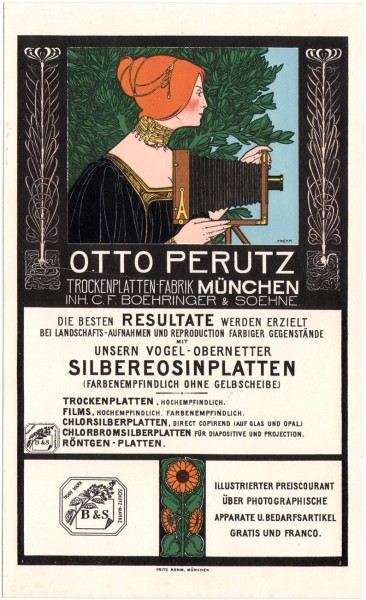Otto Perutz Lithographic Advertising Card
ArtistFritz Rehm
CountryGermany
MediumLithograph
JournalPhotographisches Centralblatt 1898
EphemeraAdvertising Matter
AtelierFritz Rehm (Munich)
Year1898
View Additional Information & Tags
Advertising, Artists, Engraving
Dimensions
Image Dimensions: 20.8 x 13.0 cm including frame
Support Dimensions: 23.4 x 14.2 cm thin white coated cardstock
Associated Highlights:
Photographisches Centralblatt: 1895-1903, Photographic showcase for the Munich Secession
Color photography, or at least the best results a photographer could obtain when photographing colored objects (1) in the late 1890’s was possible with the purchase of specially sensitized dry plates manufactured by Munich’s Otto Perutz. (1847-1922) The simple message of beauty and color obtained by Perutz plates is reinforced with the modern Jugenstil artwork of a woman focusing a tripod-mounted plate camera displayed on this advertising trade card.
To this end, the marketing division of the Perutz dry plate factory in Munich commissioned Munich illustrator Fritz Rehm (1871-1928) sometime in the late 1890’s to create artwork and graphics advertising these plates, with an emphasis on the benefits pertaining to color rendition achieved by their Eosin silver plates. Hermann Wilhelm Vogel, who co-invented them along with J.B. Obernetter, (earlier, Vogel had invented color-sensitizers in photography) commented on these plates when first introduced in 1887:
…”Obernetter and myself have succeeded in preparing Eosin silver plates which yielded good instantaneous exposures (now when the winter sun at noon is not brighter than it is at 7 o’clock in the evening in midsummer) while an ordinary plate gave only the highest lights.
This high degree of sensitiveness gives the Eosin silver plate the advantage, to say nothing of the rendering of the proper color values.
But he must direct attention to the fact that the introduction of the new process will necessarily be attended with a percentage of failures.” 2.
This beautiful multiple-color lithograph printed on thin, white, coated cardstock was found inserted loosely in the May issue of Photographisches Cenralblatt, an issue devoted to the work of Professor Paul Hoecker, (1854-1910) a painter and one of the founders of the Munich Secession. Although it is not known if the card is original to the issue, multiple examples of this advertisement for Otto Perutz plates printed as black & white halftone advertisements appear in multiple issues of the journal for 1898, including the first January number.
It is most possible Fritz Rehm and Paul Hoecker knew each other as they were both contributing artists to the illustrated weekly magazine Jugend. (Münchner illustrierte Wochenschrift für Kunst und Leben) (Youth: the illustrated weekly magazine of art and lifestyle of Munich) This artwork can also be found in the form of a poster, (42.0 x 66.0 cm) issued with the inclusion of two black and white photographs taken with Perutz-manufactured plates at the foot of the poster.
Translation of the advertising copy for this advertising card:
Otto Perutz Dry Plate factory in Munich Inh. C.F. Boehringer & Soehne.
For the best Results achieved in landscape photography and reproduction of colored objects with our Vogel-Obernetter Eosin-Silver-Plates (color sensitivity without yellow plate)
Dry plates, high sensitivity.
Films, high sensitivity, color sensitivity.
Silver chloride plates, direct copying (on glass and opal)
Chlorbromsilberplatten for slides and projection.
X-ray plates.
1. Autochrome color positive photographic plates invented by the Lumière Brothers of France first marketed in 1907 were the first true color photographs a photographer could achieve in-camera.
2. Concerning the New Eosin Silver Plates: H. W. Vogel: Translated from the Photo Notizen: in: American Journal of Photography: Philadelphia: Thomas H. McCollin & Co., Publishers: Volume VIII, 1887: p. 32
